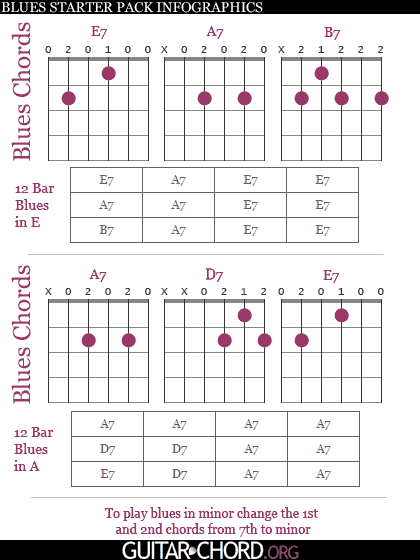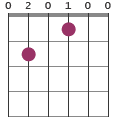Blues – the basics
Guitar is the archetypical instrument for playing blues and it has been a part of the genre since the beginning. There are two fundamental areas to study to begin with if you want to learn the blues: rhythm and chords.
Chords
The typical blues chords are the so-called dominant, written with a seven (7) after the tone as in the chord name C7. Compare a regular C major chord with a C7 and decide for yourself which sound most bluesy.
There is a dedicated lesson on chord progressions in blues, but a sample of some very common chords in this genre are E7, A7 and B7.
E7
A7
B7
Major or minor?
Blues can be played in both major and minor. For example, fast blues are generally played in major and blues in minor tends to be slower. Instead for using the chords E7, A7 and B7 you can change to minor blues by instead using Em, Am and B7.
Rhythm
One ingredient for creating bluesy sound on your guitar is adept to a certain rhythm. This is by no means based on strict rules that will dictate exactly how you should play, but often you will accentuate the first and third beat on every four beats.
1 2 3 4 1 2 3 4 and so on ...
When you exercise on this, begin by only using downstrokes.
This is also part of the special shuffle feel, or tripet feel, that is central in the rock 'n' roll sides of blues.
Sound example 1, blues shuffle with triplet feel:
Sound example 2, blues shuffle with no triplet feel:
An underestimated way to grasp this is to listen to the music. It's kind of obvious: listen to blues and you will get the rhythm. Here are some of the most famous among blues guitarists:
- Muddy Waters
- John Lee Hooker
- T-Bone Walker
- Elmore James
- BB King
- Albert King
- Stevie Ray Vaughan
A few tips on albums: Born Under a Bad Sign (1967) with Albert King, T-Bone Blues (1959) by T-Bone Walker, The Legendary Modern Recordings 1948-1954 (1994) compilation with John Lee Hooker, Blues Breakers with Eric Clapton (1966) by John Mayall and At Fillmore East (1971) live with The Allman Brothers Band.
The structure – 12 Bar Blues
12 Bar is the name of the most common structure in blues. You have just learned that E7, A7 and B7 are good chords to know, here is a basic structure that instructs you how to use them together:
| E7 | E7 | E7 | E7 |
| A7 | A7 | E7 | E7 |
| B7 | A7 | E7 | E7 |
Every bar contains four beats. As we go on with this course we will see more complex progressions including turnarounds, and also other structures.
Major or minor?
Blues can be played in both major and minor. For example, fast blues are generally played in major and blues in minor tends to be slower. Instead for using the chords E7, A7 and B7 you can change to minor blues by instead using Em, Am and B7.
| Em | Em | Em | Em |
| Am | Am | Em | Em |
| B7 | Am | Em | Em |
Go to next article in the course: Blues chord progressions.
Go back to the main section of Blues guitar.
In compressed form
Here are the basic chords and progressions in the two most used keys for blues guitar:



